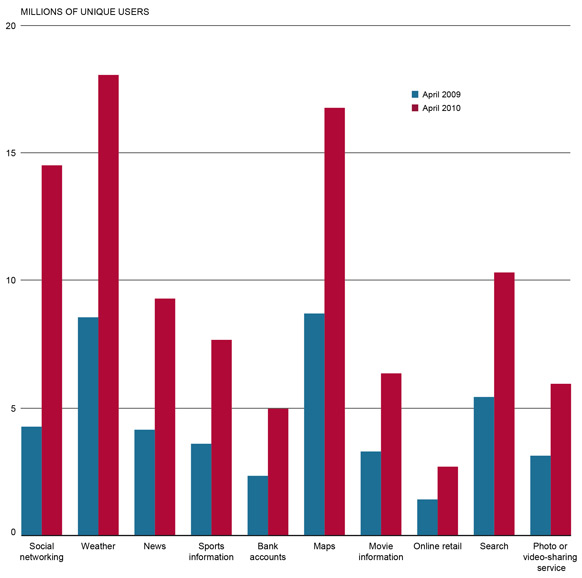The Mobile Device Is Becoming Humankind's Primary Tool (Infographics Feature)
Worldwide Mobile Data Usage Forecast, by Region

Chart 1: Western Europe and the Asia-Pacific region will account for nearly 60 percent of worldwide mobile data traffic by 2014. But emerging markets such as Central and Eastern Europe, Latin America, and the Middle East and Africa, having started with relatively small numbers, are growing the fastest.
Source: Cisco
Mobile-Phone Accounts Approach Level of World Population

Chart 2: Mobile service is among the fastest-spreading technologies in history. The number of mobile-phone accounts worldwide has doubled, to about 5.5 billion, over the past five years, while world population has reached nearly 6.7 billion.
Note: These data track accounts, not individuals, and some people have two or more accounts.
Source: International Telecommunication Union
Changes in Mobile Internet Activities, 2006-2011
Percentage of respondents reporting or projecting mobile activities

Chart 3: E-mail is the most common Internet application that people report using on their mobile devices in a typical week. With the rise of smart phones, e-mail seems to be displacing text messaging to some extent. Social networking, audio streaming, music, and games are seeing strong growth.
Source: Bridge Ratings/eMarketer
Social Networking and Mapping Lead the Pack of Mobile Apps

Chart 4: A survey of Americans over 13 shows that the fastest-growing category of mobile apps is social networking, which includes utilities such as Facebook and Twitter. Weather, mapping, and search apps are also used by more than 10 million people in the United States.
Source: ComScore MobiLens
Free versus Paid Apps, by App Store

Chart 5: Apple’s App Store and the Windows Marketplace narrowly lead BlackBerry and Nokia in distributing apps that must be purchased. The majority of apps distributed through the Google Android Market are free.
Note: Figures are U.S.-only, except for global figures for BlackBerry. Numbers may not add up to 100% because some people use both free and paid apps.
Source: Distimo / eMarketer
Privacy Tradeoffs: Mobile Internet Users Who Would Be Willing to Automatically Share Their Location Data in Return for Benefits

Chart 6: Despite concerns about privacy, a significant percentage of consumers are willing to share their whereabouts with businesses, so long as they get benefits in return. Top benefits cited are coupons, free apps, faster payment capabilities, and directions to sellers of desired goods.
Source: Mobile Marketing Association / eMarketer
Graphics by Mark McKie
Keep Reading
Most Popular
Large language models can do jaw-dropping things. But nobody knows exactly why.
And that's a problem. Figuring it out is one of the biggest scientific puzzles of our time and a crucial step towards controlling more powerful future models.
How scientists traced a mysterious covid case back to six toilets
When wastewater surveillance turns into a hunt for a single infected individual, the ethics get tricky.
The problem with plug-in hybrids? Their drivers.
Plug-in hybrids are often sold as a transition to EVs, but new data from Europe shows we’re still underestimating the emissions they produce.
Stay connected
Get the latest updates from
MIT Technology Review
Discover special offers, top stories, upcoming events, and more.